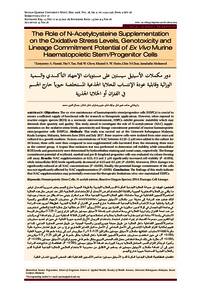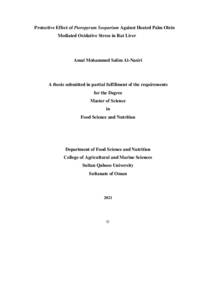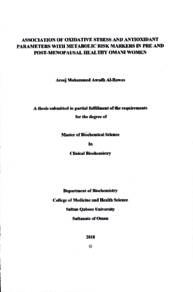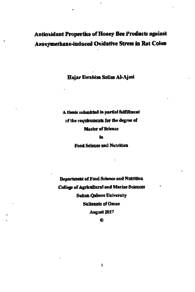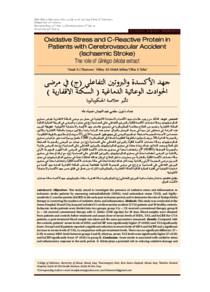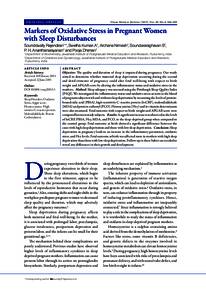Document
The Role of N-acetylcysteine supplementation on the oxidative stress levels, genotoxicity and lineage commitment potential of Ex vivo murine haematopoietic stem/progenitor cells.
Contributors
Other titles
دور مكملات الأستيل سيستين على مستويات الإجهاد التأكسدي والسمية الوراثية وقابلية عودة الإنتساب للخلايا الجذعية المستخلصة حيويا خارج الجسم في الفئران أو الخلايا الجذرية
Publisher
College of Medicine, Sultan Qaboos University.
Gregorian
2018-05
Language
English
English abstract
Objectives: The ex vivo maintenance of haematopoietic stem/progenitor cells (HSPCs) is crucial to ensure a sufficient supply of functional cells for research or therapeutic applications. However, when exposed to reactive oxygen species (ROS) in a normoxic microenvironment, HSPCs exhibit genomic instability which may diminish their quantity and quality. This study aimed to investigate the role of N-acetylcysteine (NAC) supplementation on the oxidative stress levels, genotoxicity and lineage commitment potential of murine haematopoietic stem/progenitor cells (HSPCs). Methods: This study was carried out at the Universiti Kebangsaan Malaysia, Kuala Lumpur, Malaysia, between June 2016 and July 2017. Bone marrow cells were isolated from nine mice and cultured in a growth medium. Various concentrations of NAC between 0.125–2 μM were added to the culture for 48 hours; these cells were then compared to non-supplemented cells harvested from the remaining three mice as the control group. A trypan blue exclusion test was performed to determine cell viability, while intracellular ROS levels and genotoxicity were determined by hydroethidine staining and comet assay, respectively. The lineage commitment potential of erythroid, myeloid and pre-B-lymphoid progenitor cells was evaluated via colony-forming cell assay. Results: NAC supplementation at 0.25, 0.5 and 2 μM significantly increased cell viability (P <0.050), while intracellular ROS levels significantly decreased at 0.25 and 0.5 μM (P <0.050). Moreover, DNA damage was significantly reduced at all NAC concentrations (P <0.050). Finally, the potential lineage commitment of the cells was not significantly affected by NAC supplementation (P >0.050). Conclusion: The findings of this study indicate that NAC supplementation may potentially overcome the therapeutic limitations of ex vivo-maintained HSPCs.
Member of
Resource URL
Citation
Hamid, Zariyantey A., Tan, Hui Y., Chow, Paik W., Harto, Khairul A. W., Chan, Chin Y., & Mohamed, Jamaludin (2018). The Role of N-Acetylcysteine Supplementation on the Oxidative Stress Levels, Genotoxicity and Lineage Commitment Potential of Ex Vivo Murin
Arabic abstract
إن صيانة الخلايا الجذعية المكونة للدم والخلايا الجذرية بالطريقة الحيوية خارج الجسم يعتبر ضرورياً لضمان توفير ما يكفي من الخلايا المختبرية الحيوية والقابلة للإستخدام لغرض الأبحاث أو للإستخدامات العلاجية، لكن عند تعرض مثل هذه الخلايا لعناصر الأكسجين التفاعلية في بيئة متعادلة، تظهر الخلايا الدموية الجذعية حالة عدم استقرار جيني مما قد يقلل من عددها وجودتها، لذلك هدفت هذه الدراسة إلى معرفة دور مكملات الأسيتيل سيستين - Nacetylcysteine) في مستويات الإجهاد التأكسدي والسمية الوراثية وقابلية عودة الإنتساب للخلايا الجذعية المستخلصة خارج الجسم في الفئران أو الخلايا الجذرية. الطريقة: أجريت هذه الدراسة في جامعة كيبانجسان في كوالا لمبور ماليزيا، في الفترة بين يونيو 2016 ويوليو 2017، تم خلالها عزل خلايا النخاع العظمي استخرجت من عدد تسعة الفئران وتم تربية الخلايا في وسط استنبات تمت إضافة الأسيتيل سيستين بتراكيز تتراوح بين 2-0.125 ميكرومتر للوسط الاستنباتي ولمدة 48 ساعة، ثم تمت مقارنة هذه الخلايا بخلايا تم استخلاصها من الفئران الثلاثة المتبقية دون أن يتم اضافة أي مركبات لها لتقوم بدور مجموعة الضبط، تم إجراء اختبار استبعاد باستخدام التريبان الأزرق لتحديد حيوية الخلية، في حين تم تحديد مستويات عناصر الأكسجين التفاعلية داخل الخلايا عن طريق صبغة هيدروإثيدين والسمية الجينية عن طريق فحص المعايرة المذنبي، كما تم تقييم إمكانية التزام الخلايا الإنتسابي إلى الأصل النخاعي أو الأصل ما قبل التمايز اللمفاوي نوع - ب عن طريق اختبار معايرة خلية مكونة لكتلة الاستنبات. النتائج مكملات الأسيتيل سيستين بالتراكيز ،0.25 ، 0.5 و 2 ميكرومتر أدت إلى زيادة ملحوظة في حيوية الخلية (0.050>P)، في حين انخفضت مستويات عناصر الأكسجين التفاعلية داخل الخلايا بشكل ملحوظ في التراكيز 0.25 و 0.5 ميكرومتر (0.050 > P)، علاوة على ذلك، لوحظ انخفاض معدل تلف الحمض النووي بشكل ملحوظ في جميع تركيزات الأسيتيل سيستين (0.050>P). وأخيرا، لم يتأثر التزام النسب المحتمل للخلايا بدرجة كبيرة بعد اضافة الأسيتيل سيستين (0.050 > P). الخلاصة: إن نتائج هذه الدراسة تشير إلى أن اضافة مكملات الأسيتيل سيستين قد يساهم في التقليل من محدودية الاستخدام العلاجي للخلايا الجذعية المكونة للدم والخلايا الجذرية المستنبتة حيويا خارج الجسم.
Category
Journal articles

